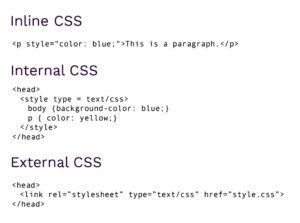
Understanding HTML, CSS, and JavaScript Differences
In the realm of website creation, a plethora of coding languages are at developers’ disposal, each with its own complexity and utility. From foundational languages like HTML to dynamic scripting with JavaScript, the landscape is rich and diverse. Understanding the nuances and functionalities of these languages is crucial for aspiring web developers seeking to build immersive online experiences. This exploration delves into the intricacies of JavaScript and HTML, two cornerstone languages in the realm of web development.
A Comparative Analysis: How to choose HTML vs CSS vs JavaScript?
JavaScript: Enhancing Interactivity
JavaScript, a versatile programming language, serves as the backbone for crafting websites, games, and various applications. Its dynamic capabilities breathe life into web pages, enabling interactive elements beyond the scope of HTML and CSS alone. Whether it’s unveiling hidden content through dropdown menus, dynamically updating forms based on user input, or animating page elements for enhanced visual appeal, JavaScript empowers developers to create engaging user experiences that captivate and retain audiences.
JavaScript operates on the client side, executing code within the user’s web browser. This client-side scripting capability allows for real-time interaction without the need for constant server communication, thereby enhancing the responsiveness and fluidity of web applications. Furthermore, JavaScript boasts widespread browser support, making it accessible across different platforms and devices.
HTML: The Bedrock of Web Structure
Contrastingly, HyperText Markup Language (HTML) stands as the cornerstone of web development, influencing both content and layout. As a markup language, HTML defines the structure of web pages, working seamlessly with CSS and JavaScript to shape the user interface. Its simplicity and universality make it accessible to developers of all levels, facilitating the creation of search engine-friendly websites that are both visually appealing and functionally robust.
HTML serves as the foundation upon which web content is built, providing structure through elements such as headings, paragraphs, lists, and images. By organizing content hierarchically and semantically, HTML ensures clarity and accessibility for both users and search engines. Additionally, HTML forms the basis for responsive web design, allowing websites to adapt gracefully to various screen sizes and device orientations.
What are the Key Distinctions between JavaScript and HTML?
| HTML | JavaScript |
|---|---|
| Establishes the basic structure of websites | Adds interactivity and dynamism to web pages |
| Primarily rendered on the server side | Primarily executed on the client side within web browsers |
| Used for static content presentation | Enables dynamic content manipulation and updates without reloading the page |
| High cross-browser compatibility | May have browser-specific compatibility issues |
| The foundational layer of web development | Enhances user experience by making web pages interactive and aesthetically pleasing |
| Standardized and maintained by the World Wide Web Consortium (W3C) and the Web Hypertext Application Technology Working Group (WHATWG) | Standardized by the ECMA International’s Technical Committee 39 (TC39) |
| Requires Cascading Style Sheets (CSS) for visual formatting and layout | Can manipulate HTML and CSS to update the appearance and content dynamically |
| Does not require additional software or engines to be interpreted by the browser | Requires a JavaScript engine (like V8 in Chrome, SpiderMonkey in Firefox) for execution |
| Defines the content and structure of web documents through markup | Can fetch data asynchronously using AJAX, allowing for seamless updates to the displayed information |
| Lacks built-in methods for creating interactive content | Provides numerous built-in methods and libraries for creating complex features and applications |
| Markup language used to create and design web pages | Programming language that can interact with HTML and CSS |
| HTML5 introduces APIs for more interactive web applications, but still primarily focused on document structure | Supports event-driven programming, allowing actions to be performed in response to user inputs, time intervals, etc. |
Evaluating JavaScript and HTML: Complementary Roles
JavaScript and HTML, though distinct in function, operate symbiotically in website development. HTML lays the groundwork for page structure, while JavaScript elevates interactivity and user engagement. They are not competing entities but rather complementary tools in a developer’s arsenal. By leveraging the strengths of both languages, developers can create compelling web experiences that seamlessly blend form and function.
Learning Path: HTML Precedes JavaScript
For aspiring web developers, mastering HTML precedes delving into JavaScript. HTML serves as the fundamental building block, essential for understanding website structure and responsiveness. With a solid HTML foundation, learners can seamlessly transition to JavaScript, leveraging its dynamic capabilities to enhance their creations.
Advantages of Learning HTML Before JavaScript
- Foundational Understanding: HTML forms the backbone of every website, providing a crucial understanding of web development fundamentals;
- Responsive Design: Proficiency in HTML is indispensable for crafting responsive and adaptive designs that deliver a consistent user experience across devices;
- Smoother Learning Curve: Learning JavaScript is smoother with a solid grasp of HTML concepts, as many JavaScript functionalities rely on HTML structure and elements;
- Holistic Site Functionality: HTML knowledge ensures comprehensive website functionality, laying the groundwork for dynamic enhancements with JavaScript. By understanding HTML’s structure and semantics, developers can effectively integrate JavaScript to create interactive and engaging user experiences;
- Inherent Connection: JavaScript builds upon HTML, making familiarity with the latter advantageous for mastering the former. By understanding HTML’s role in web development, developers gain insight into how JavaScript interacts with and manipulates HTML elements to achieve desired outcomes;
- Enhanced Development Skills: Proficiency in HTML sets the stage for becoming a proficient web developer, fostering a deeper understanding of website architecture and design principles. By mastering HTML, developers gain a solid foundation upon which to build their JavaScript skills and further expand their expertise in web development.
Conclusion: Harnessing the Power of JavaScript and HTML
In summary, JavaScript and HTML serve distinct yet complementary roles in web development. While HTML forms the structural backbone of websites, JavaScript adds dynamism and interactivity, elevating user experiences to new heights. Embracing both languages equips developers with the tools to craft immersive and responsive web solutions that captivate and engage users. By understanding the strengths and capabilities of JavaScript and HTML, developers can unleash their creativity and bring their vision to life on the digital frontier.

